Public perception
This segment includes additional information on:
- 1Describe changes in the public concern level over the vaccine as a result of the initial reports of the death of the student shortly following HPV vaccination and follow-up reports that established that there was no connection between the vaccine and the tragedy,
- 2Explain the importance of monitoring public perception of vaccines and having a communications plan to facilitate media contacts, particularly when a new vaccine is being introduced into a programme.
Understanding public perception
Beginning three years before the introduction of HPV vaccination, the UK DH conducted surveys to understand the public attitudes and awareness of HPV and HPV vaccine among the population.
| 2005 | Initial qualitative research conducted among parents about their attitudes and awareness of HPV and HPV vaccine. |
|---|---|
| 2006 | |
| 2007 | Just over a year before the launch of the programme, surveys were carried out among students, parents and health professionals. One survey measured the opinions of HPV vaccination among parents of 8–9 year old girls. This survey was repeated among 12 year old girls and their parents. Some of these surveys provided "pre-campaign" or "baseline" data to be used to monitor changes in attitudes and awareness of HPV vaccine. This information was intended to determine the most acceptable age to target vaccination. It was important programmatically because it shifted the implementation from primary to secondary school environments. |
| 2008 | Once the vaccination programme is underway, surveys are regularly carried out to track progress and detect changes in the programme. Routine programme begins. Catch-up campaign begins. |
| 2009 | Surveys are regularly carried out to track progress and detect changes in the programme. Routine programme continues. Catch-up campaign concludes (finishing a year ahead of schedule). |
| 2010 | Routine programme continues. |
To understand the impact of the student death on the public perception of HPV vaccine, the UK DH designed a survey that would allow them to compare current public perceptions with those existing before the programme began.
Favourable public perception of HPV vaccine
In the 2007 pre-campaign survey to measure public perception of the vaccine, mothers and daughters were asked to read an information card on HPV and the vaccination programme. They were then asked how favourable they felt towards the vaccination.
In the pre-campaign survey at least four out of five respondents (80%) in each group said they were “very” or "fairly" favourable of the HPV vaccine.
Percent of mothers and daughters reporting to be "very" or "fairly" favourable toward the HPV vaccine in 2007

Question
Do you expect the percent of mothers and daughters who were “very” or “fairly” favourable toward HPV vaccine in the pre-campaign survey to have decreased in the post-campaign survey conducted after the HPV vaccine crisis?
| YES | NO |
Correct Answer: No.
There were no significant changes in the levels of favourability toward the HPV vaccine in the post-campaign survey after the death of the student.
Favourable perception remains high
After the death of the student following HPV vaccine, the UK HD again asked mothers and daughters to read an information card on HPV and the vaccination programme. They were then asked how favourable they felt towards the vaccine.
There were no significant changes in the high levels of favourability toward the HPV vaccine after the student’s death. At least four out of five respondants (80%) in each group said they were “very” or “fairly” favourable of the HPV vaccine.
Percent of mothers and daughters reporting to be "very" or "fairly" favourable toward the HPV vaccine in 2007 and 2009
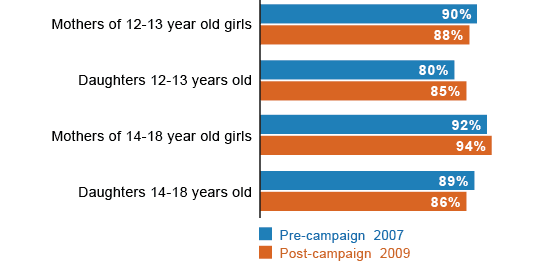
Question
Do you think most mothers and daughters knew about the death of the student shortly following HPV vaccination?
| YES | NO |
Correct Answer: Yes.
Most mothers and daughters were aware of the student who had died shortly following vaccination.
At least eight out of ten mothers and at least seven out of ten daughters were aware of the tragedy.
High awareness of student death following HPV vacination
Awareness that a student had died shortly after receiving HPV vaccination was assessed by the post-campaign survey.
To establish “spontaneous awareness,” mothers and daughters were asked what they had recently seen or heard in the media about HPV. Between two in ten and three in ten mentioned the event at this point.
Awareness of student death following HPV vaccination
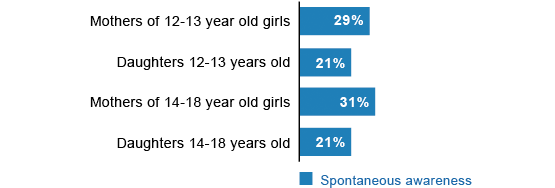
If the student death was not mentioned at this stage, respondents were asked directly if they were aware of the incident, giving the measure of “prompted awareness.” Including prompted responses, over 80% of mothers and 70% of daughters were aware of the case.
Awareness of student death following HPV vaccination
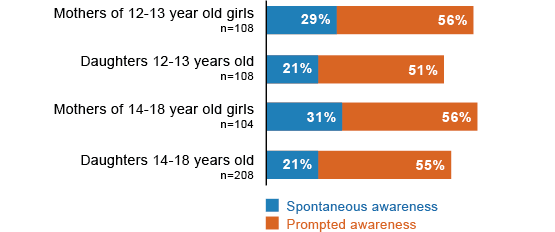
The remaining mothers and daughters were “not aware” of the incident
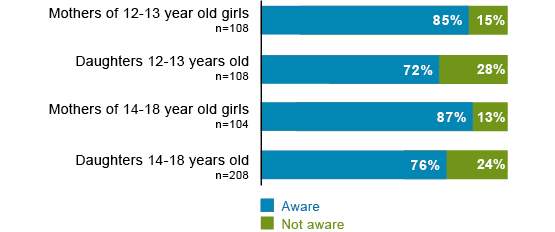
Initial concern over HPV vaccine
Those who had reported being aware of the death of the student were asked to describe how concerned they had initially felt at the time the event occurred. At least seven in ten of respondents were initially concerned about the vaccine.
Initial concern related to student death following HPV vaccination
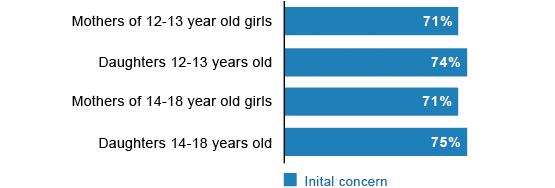
Question
When mothers and daughters were asked how concerned they currently felt, now that it was clear that the girl’s death was not linked to the HPV vaccination, most remained concerned about the vaccine?
| YES | NO |
Correct Answer: No.
Most mothers and daughters were no longer concerned about the HPV vaccine once it was established that there was no connection between the vaccine and the tragedy.
Concern over HPV vaccine falls significantly
Mothers and daughters were asked how concerned they currently felt, now that it was clear that the girl’s death was not linked to the HPV vaccination. The proportion of concerned mothers and daughters decreased significantly following release of additional details.
Awareness of student death following HPV vaccination
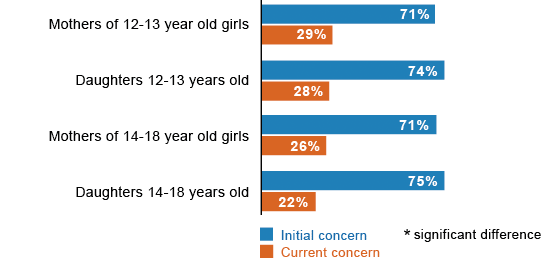
The single most common concern amongst mothers during the post-campaign survey was the risk associated with the vaccine.
It is not surprising that this concern increased following the death of the student. Even though it was established that there was no connection between the vaccine and the girl’s death, general concerns over safety will be uppermost in people’s minds as a result.

